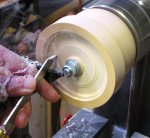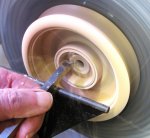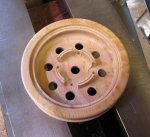Dave Hawksford
Member
- Messages
- 7,709
- Location
- Outside the beltway
Today I've decided to give the Yew a go. I knew it was going to be a challenge. The grain is all over the place. The 1st call I will need to order 3" slate top before I go futher. The 2nd I was about done with the inside and then , snap ! It's gone. I have to pieces left and the one the needs the 3" top. I need to take a breather and think about this turn. I'm not settled or relaxed enough to proceed today.
Think I'll sit back and talk to the birds lol till Sheely gets here and we head out to a family gathering shortly.
Looking at the break I see I had a bad hold plus the edge was a bit dual I think. I just switched to a small convexed gouge either I took pressure off or tilted the wrong way. IDK
Think I'll sit back and talk to the birds lol till Sheely gets here and we head out to a family gathering shortly.
Looking at the break I see I had a bad hold plus the edge was a bit dual I think. I just switched to a small convexed gouge either I took pressure off or tilted the wrong way. IDK
Attachments
Last edited:










